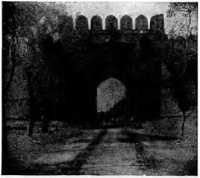Dr. P. A. S. van Limburg-Brouwer.
Translated from the Dutch by
M. M.
With notes and an introductory life of the Emperor Akbar,
By
Clements R. Markham. C.B., F.R.S.
Year
1879
Akbar's wives were Sultana Rajmihal Begum, a daughter of his uncle Hindal, by whom he had no children; Sultana Sulimah Begum, a daughter of a daughter of Baber, who was a poetess; and the Rajput Princess Jodh Bai, the mother of Salim.
His children were Hasan and Husain, who died in infancy; Salim, his successor; Murad and Danyal, who died of drink in the lifetime of their father, and three daughters.
Akbar is described by his son Salim as a very tall man, with the strength of a lion, which was indicated by the great breadth of his chest. His complexion was rather fair (color de trigo is the description of a Spanish missionary who knew him), his eyes and eyebrows dark, his countenance handsome. His beard was close-shaved. His bearing was majestic, and "the qualities of his mind seemed to raise him above the denizens of this lower world."21 The Emperor Akbar combined [xxxi]the thoughtful philosophy of Marcus Aurelius, the toleration of Julian, the enterprise and daring of his own grandsire Baber, with the administrative genius of a Monro or a Thomason. We might search through the dynasties of the East and West for many centuries back, and fail to discover so grand and noble a character as that of Akbar. No sovereign has come nearer to the ideal of a father of his peopleYet another reference another source equally old
As early as 1562 Bhagvan's father, Raja Bihari Mal, the lord of Amber and ancestor of the present maharajas of Jaipur, had come to pay his homage to the new sovereign. "He was received with great honour and consideration, and his daughter, an honourable lady, was accepted by his Majesty, and took her place among the ladies of the court." Akbar had already married his cousins Rukayya and Salima, but this union with a Rajput princess marked a new policy. Her father was decorated with the highest rank of the official aristocracy, as a mansabdar, or general of five thousand horse, and the bride, freely exercising the rites of her own faith and performing the usual Hindu sacrifices, encouraged her husband's tendency towards religious toleration. Later on he took other women, Hindu, Persian, Moghul, and even an Armenian, until his harem formed a parliament of religions, though no rumour of their probable debates ever reached the outside world. Abu-l-Fazl says there were more than five thousand inmates of the harem, in various capacities, and sagely remarks that "the large number of women - a vexatious question even for great statesmen - furnished his Majesty with an opportunity to display his wisdom."
An almost immediate result of this alliance with the Rajput princess was the abolition in 1562 of the jizya, or poll-tax, which Mohammedan conquerors levied upon unbelievers in accordance with the law of Islam. His next act was to discontinue the tax upon
Page 16

Agra Gate, Fathpur-Sikri
Hindu pilgrims, on the ground that, however superstitious the rites of pilgrimage might be, it was wrong to place any obstacle in the way of man's service to God. No more popular measures could have been enacted. The jizya was an insult as well as a burden, and both taxes bore heavily on the poor and were bitterly resented.
It was the re-imposition of the tax on religion in the time of Aurangzib that, more than anything else, uprooted the wise system established by his ancestor. But while conciliating the Hindus by just and equal government, Akbar did not hesitate to interfere with some of their most cherished practices when they offended his sense of, humanity. He forbade child-marriage, trial by ordeal, and animal sacrifice; he...































